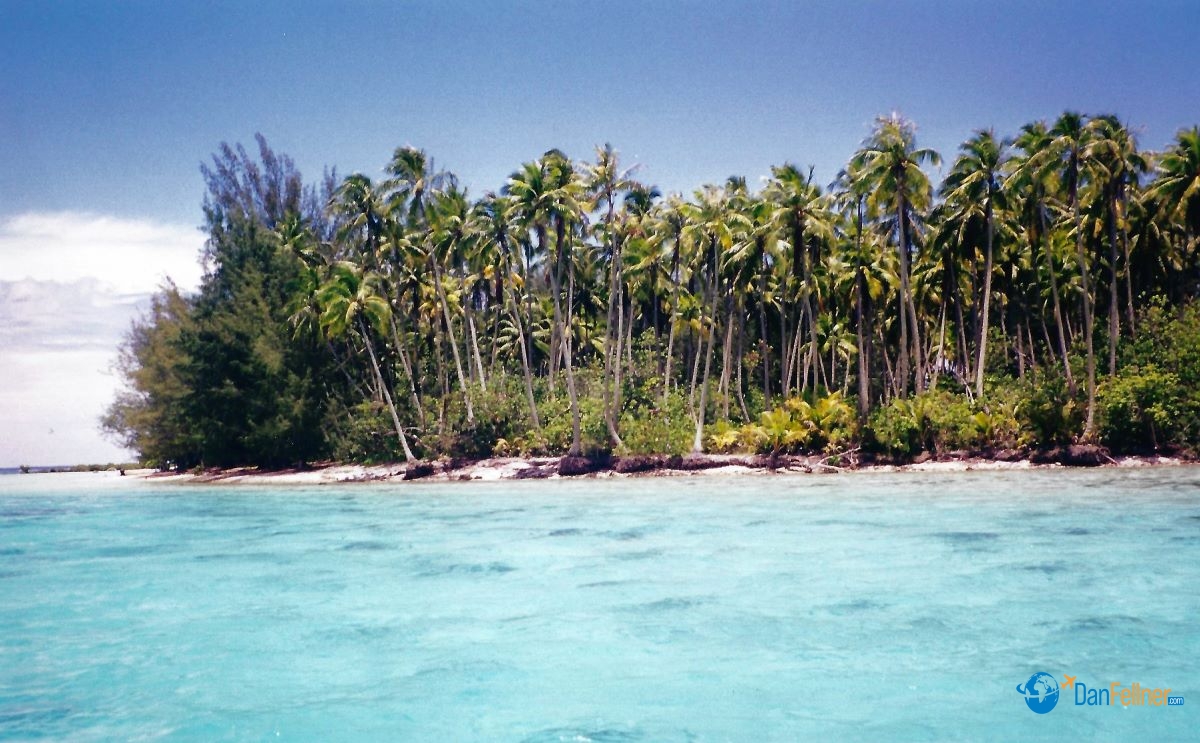French Polynesian island offers spectacular scenery
East Valley Tribune — February 25, 2001

Moorea’s famed Mount Mouaroa is the French Polynesian island’s trademark.
The French Polynesian island’s dramatic scenery of jagged peaks towering over lush valleys, turquoise lagoons, coral reefs and white-sand beaches has appeared in numerous movies. Hollywood producers know a good thing when they see it.
So do the thousands of tourists who visit Moorea (pronounced Moe-oh-ray-ah) each year, making it French Polynesia’s second-most popular destination, behind nearby Tahiti.
Many of them arrive by cruise ship, which is the easiest and financially savviest way of seeing French Polynesia, one of the most expensive places on earth.
Hotels here can easily cost more than $500 a night. And food — aside from locally grown fresh fruist — is no bargain either. But the cost of lodging and food is included in the price of a cruise, so your only out-of-pocket expenses are for shore excursions and shopping.

The jagged peaks of Moorea, an island in the South Pacific.
We were aboard Renaissance Cruises’ R3, a 1999-built midsize ship that sails out of Papeete, Tahiti, and visits four other French Polynesian islands — Moorea, Bora Bora, Raiatea and Huahine — over the course of 10 days. (Note: Renaissance Cruises filed for bankruptcy in 2001; The R3 was purchased by Princess Cruises in 2002 and now sails under the name “Pacific Princess.” Several of the other R-class ships are now operated by Oceania Cruises).
Tahiti is the commercial center and the largest and best-known island in French Polynesia, while glamorous Bora Bora is the destination of choice by the rich and famous.
But we found our two-day visit to Moorea to be the highlight of the cruise. It is much cleaner and quieter than Tahiti, and less touristy and jaded than Bora Bora. And its scenery is spectacular.
Moorea, which means “yellow lizard” in Polynesian, covers an area of 51 square miles and is home to about 12,000 permanent residents. About 300 of them commute each day to Tahiti, which is 12 miles to the east. It’s a 30-minute ferry ride, although Polynesians not in a hurry have been known to swim between the two islands, which can take about eight hours.
French Polynesia consists of about 130 islands in the South Pacific. It is officially called an “overseas territory” of France, meaning the people can vote in French presidential elections and elect representatives to the French parliament. There has been some talk of seeking independence from France, but our guides said most of the locals prefer the status quo.
French and Tahitian are the two predominant languages here, although English also is widely spoken.
While tourism is key to Moorea’s economy, it has not engulfed the island and jaded its residents. I’ve never seen so many local stop where they’re doing to smile and wave as our bus traversed the island.
There are just a few luxury hotels on Moorea, and only three relatively small cruise ships — Renaissance’s R3 and R4 and Radisson’s Paul Gauguin — sail these waters year-round. It’s a far cry from the Caribbean, where you can sometimes find a half dozen mega-ships docked in the same port at the same time.
Polynesian legend has it that Moorea was created when a magical fish swam from the lagoon of a neighboring island and turned into Tahiti. It apparently was a large fish, as its second dorsal fin became Moorea. Geologists have a somewhat different view. They believe the island is what remains of a massive volcano.
If Moorea has a trademark, it would be the cathedral-like Mount Mouaroa or “Bali Hai Mountain,” also known as “Shark’s Tooth.” It is best known for its appearance in the movie “South Pacific.” The stunning peak also can be seen on numerous postcards as well as on the coins of the currency of French Polynesia (CFP).
Indeed, the mountain scenery is as striking as you’ll see on any tropical island, prompting the famed author James Michener to once call Moorea “a monument to the prodigal beauty of nature.”
The island owes its beauty to the long-extinct volcano, whose crater has eroded into the majestic peaks that resemble the profile of a daredevil’s favorite roller coaster. They rise above two scenic bays — Cook’s and Opunohu.
It was Opunohu Bay that was the setting for 1983’s “The Bounty,” starring Mel Gibson. It tells the story of Capt. William Bligh, who sailed these waters in the late 1700s before running into a bit of trouble with his subordinates. Appropriately, the close-circuit television system on the R3 continually showed both “The Bounty” and “South Pacific,” not to mention episodes of “Gilligan’s Island.”
There are numerous ways to see Moorea’s sites, and we experienced as many as time permitted during our two days on the island. A good way to get your bearings is with a bus tour.
You’ll take a winding road up to perhaps the most breathtaking lookout point in all the South Pacific — Belvedere. There, you’ll see gorgeous views of Bali Hai Mountain and the valleys and bays below.
On the way up to Belvedere, you’ll pass shrimp farms and a 400-year-old marae, or stone Polynesian temple. While Moorea has several maraes, they aren’t as well restored or extensive as those on some of the other islands, particularly Raiatea. Still, they provide an interesting glimpse into Polynesia’s past, and you’ll hear stories of human sacrifices that once took place at these sites.
There’s also a visit to the Jus Fruits de Moorea, a factory where you can watch locally grown pineapples, grapefruit, papayas, mangos, coconuts and bananas be converted into juice and liquors, which are sold throughout French Polynesia and exported to France. They give free samples.

A deserted atoll near Moorea in the South Pacific.
If you want to learn more about Polynesian culture, spend some time at the Tiki Theater Village, built like an ancient village. You can watch locals create traditional arts and crafts and observe tattooing demonstrations. In fact, French Polynesia is the birthplace of the tattoo, and you’ll see more tattoos on these islands than at a Motley Crue concert.
For those who don’t mind a few bumps in the road, a four-wheel drive “safari” tour is an ideal way to see Moorea’s bamboo forests and fruit plantations and learn about the island’s flora and fauna. We sampled fresh-picked pineapple — the sweetest we’ve ever tasted — and grapefruit, bananas and passion fruit.
A visit to Moorea wouldn’t be complete without spending some time on a deserted atoll, or motu,that you’ll find near all of the French Polynesian Islands.
You can visit a motu on your own or book a tour, in which a catamaran will drop you off for a few hours of snorkeling, sunbathing and a buffet barbecue lunch, complete with native music. After dessert, there’s a coconut tree-climbing demonstration, and you can mingle with the friendly stingrays that swim in the lagoon. Gilligan never had it so good.
Of course, Moorea is a playground for lovers of water sports. There’s deep-sea fishing, scuba diving, snorkeling, jet skiing, water skiing, windsurfing, speedboat rentals, glass-bottom boat cruises and dolphin and whale-watching excursions.
I tried parasailing for the first time in Moorea, which looked a bit too dicey for me when I watched braver tourists do it in Mexico. There, you take off from land as a speedboat pulls you into the air. If all goes according to plan, you land in the same place, into the arms of the operators who help brace your fall on the beach.

Parasailing is one of the many water sports offered in Moorea.
In Moorea, parasailing is so much easier. You take off from a boat, sail 200-feet into the air to enjoy the awesome views of Cook’s Bay, then are safely reeled back into the boat like a tuna or marlin found in the sea here. Nothing is left to chance. It’s pricey, though — a 12-minute ride costs $60.
It’s not difficult to figure out why “Conde Nast Traveler” magazine voted Moorea the sixth-most romantic island in the world. Nor is it hard to see why the island’s scenery is used in so many movies.
But don’t wait for Moorea to once again appear in a theater near you. The silver screen can’t come close to doing the place justice.



